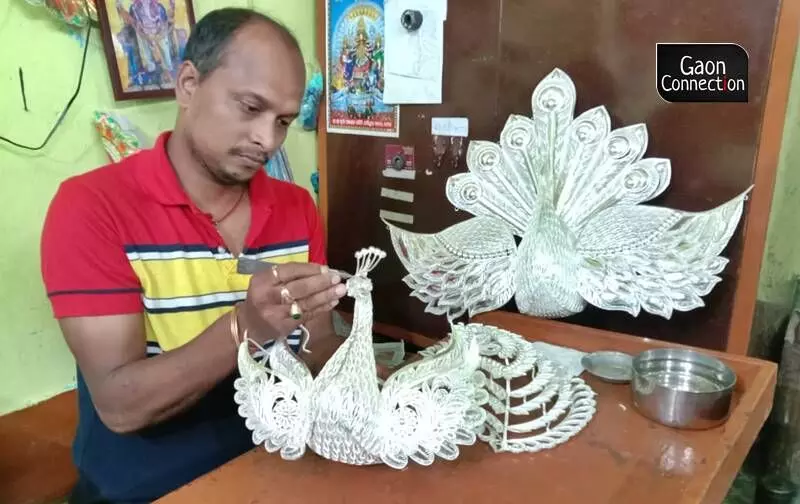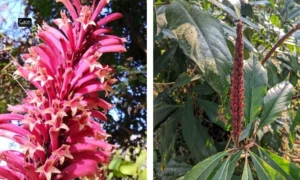This year Maa Durga is bringing back some cheer to the silver filigree artisans of Cuttack in Odisha. Business was down for the last two years due to the pandemic, but this year the craftspeople have been working all night long to make sure they welcome the goddess with the best silver decorations and offerings they can possibly create for her.
This year Durga Puja is being celebrated from October 1 to October 5, and beautiful pandals are being set up for Durga and also Saraswati, Lakshmi, Ganesha, and Karthik.
Cuttack is well known for its delicate silver filigree work and there are about 200 silversmiths who are banking on the puja festivities this year to earn handsomely.
Artisans are creating beautiful accessories in silver called Chandi Medhas (chandi means silver and medha means tableau) at the puja pandals across Cuttack. Silversmiths embellish the goddess and the space where she stands with silver filigree work.

The silver filigree work is as old as 500 years, may be more.
“The Chandi Medha was first introduced at the Choudhury Bazaar puja pandal where 300 kilogrammes of silver were used to decorate the pandal in 1956 in Cuttack,” Biswanath De, a 58-year-old artisan of Cuttack told Gaon Connection.
Also read: The 12th century craft of Pipili work in Odisha losing its vibrancy
“Filigree work of Cuttack is also known as Tarakasi. The demand for silver filigree works for the Chandi Medhas keep us busy at this time. This year, not just Cuttack but six other puja committees from Bhubaneswar and Dhenkanal have also decided to go with silver decoration,” he said happily.
In many of the annual pujas, the silver work is reused from past years. The accessories are repaired, polished and refurbished, De said.
Silver filigree work of Cuttack
Haripada Das and his entire family are bent over their craft. They are busy fulfilling orders to make decorative filigree items that will decorate puja pandals.
“Some puja committees have also placed orders for us to create entire costumes in silver filigree for the earthen images of Maa Durga,” the 48- year-old Haripada Das who lives in Dagarapada in Cuttack, told Gaon Connection.
Also Read: The Jaukandhei lac doll-making tradition of Odisha sees a revival
The silver filigree work is as old as 500 years, may be more, explained artisan Pankaj Sahoo who lives in Chandni Chowk in Cuttack. “We make necklaces, toe rings, anklets, waist bands, bracelets, vermillion boxes, brooches, pendants, earrings, hairpins, figures of animals and birds, and even miniature handbags and other souvenirs,” he said.

An artisan earns anything between Rs 10,000 and Rs 30,000 per month depending on what they do.
But, according to Sahoo the best time of the year and the most profitable for them were the months leading to Durga Puja. “It costs around Rs 75 lakh to one crore rupees to make a Chandi Medha. Just repairing and polishing a Chandi Medha costs anything between one to three lakh rupees,” he said.
In Cuttack alone there are 28 Chandi Medhas that require refurbishing and repairs on them, Sahoo pointed out.
The silver filigree work is no mere decoration. “Our filigree works don’t perish, they write history. So, when we are creating something, it’s almost like we are documenting history, which will stand the test of time and be there for our next generation,” Pravat Das, a craftsperson from Cuttack, said.
Also Read: The heritage village of Odisha where every single resident is a pattachitra artist
Need to keep the art alive
As it has been with other handicrafts, skilled filigree artisans are dwindling. It is not the best source of income and younger people are drifting away to other professions where they can earn more. And, since most of the income happens only annually during the pujas, most young people are looking elsewhere for a more steady and sustainable source of income.
“Some of us, who are still practising the age-old craft are doing so only to keep the art-form alive. Otherwise, one cannot make both ends meet in this profession,” 54-year-old artisan Narayan Das told Gaon Connection.
An artisan earns anything between Rs 10,000 and Rs 30,000 per month depending on what they do. They purchase the silver from the market which is around Rs 61,000 a kg. It is usually men who do the silver filigree work.
Also Read: The Dongria Kondh tribal women weave an income out of their traditional shawls
The coronavirus pandemic was a further blow. But, this year things seem to be looking up as a lot of artisans have come back to their traditional work of filigree work, as they received orders from several Puja committees to decorate or repair the ‘Chandi Medha’, Narayan Das said.
Also, the government managed Odisha Rural Development and Marketing Society invites artisans to open stalls in melas in the state and outside state to sell their creations.
















